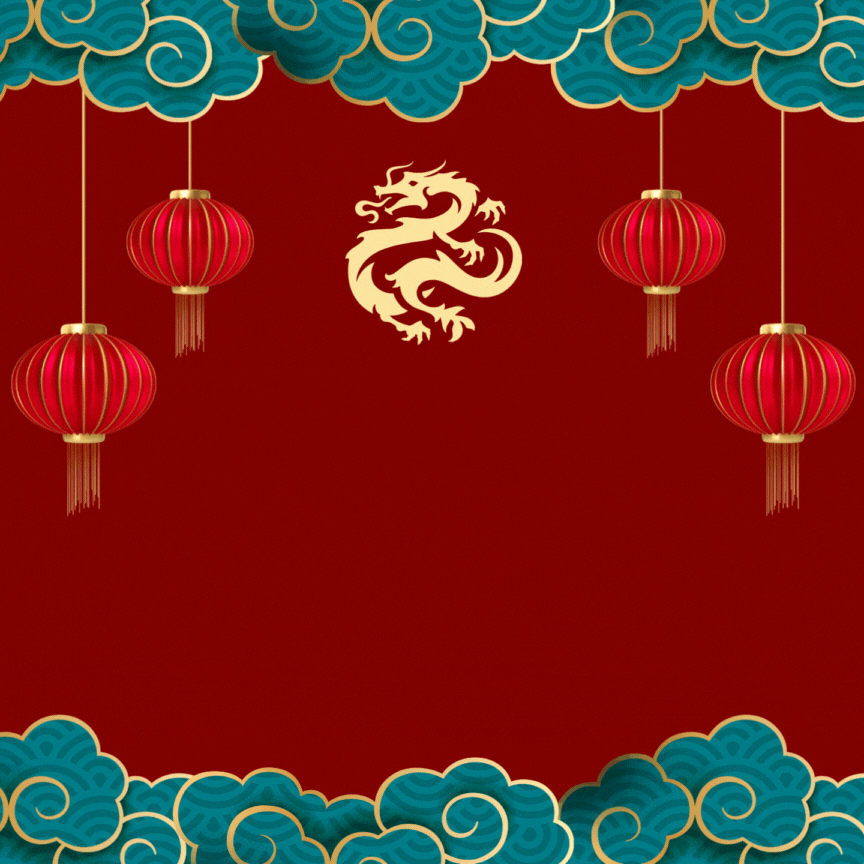Chinese New Year: Year of the Dragon
1. Symbolism of the Dragon:
Explore the cultural significance and symbolism of the dragon in Chinese mythology and folklore.
A Symbol of Prosperity
The origins of the Chinese dragon remain a topic of debate among historians and archaeologists. One of the earliest known depictions dates back to the Neolithic Yangshao Culture, discovered in a tomb in Puyang, Henan, dating back 5,000–7,500 years. Another significant find is the Jade Dragon from the Hongshan Culture in Inner Mongolia, dating back five millennia.
According to Marco Meccarelli, an art historian, there are four main theories about the origins of the dragon: a deified snake with attributes from various animals, a representation of the Chinese alligator, a symbol of thunder and rain, and a product of nature worship.
Many of these theories highlight the dragon's association with water, as it was believed to have power over this element, making it an important deity for agriculture and ensuring a prosperous harvest. Different regions in ancient China added features of animals familiar to them to the dragon's image, reflecting their local environment and culture.

A Symbol of Power
The dragon became a symbol of imperial power in China. Legends depict the mythical Yellow Emperor being carried to the afterlife by a Chinese dragon. The dragon was also believed to have fathered emperors, with Liu Bang, the first emperor of the Han dynasty, claiming to be born after his mother had a union with a dragon.
Xiaohuan Zhao, an associate professor, explains that the dragon's totem and influence were used as a political tool to wield power in imperial China. The dragon's significance continued across dynasties, with the emperor's throne referred to as the Dragon Throne, and every emperor hailed as "the true Dragon as the Son of Heaven."

A Symbol of Unity
While the dragon motif gained popularity outside China, its influence within the country grew in the 1980s. In 1978, Taiwanese musician Hou Dejian composed "Heirs of the Dragon" in response to the U.S.'s recognition of the People's Republic of China (PRC) as China's legitimate government, leading to a severance of diplomatic ties with Taiwan. The song resonated with both Taiwanese and mainland Chinese audiences.
As China's strength grew, its government sought a unifying emblem for prosperity and inclusivity. "Heirs of the Dragon" was seen as a potential symbol, and Hou performed it on a Chinese state variety show in 1988 to mark the Year of the Dragon. However, the song also became a protest anthem, particularly before the 1989 Tiananmen Square crackdown, reflecting dissent against the Chinese leadership.
Despite political implications, the dragon remains culturally significant. Its historic symbolism and enduring popularity among Chinese people highlight its role as a living tradition, reflecting key beliefs and practices associated with the dragon totem and its influence.
2. Dragon Art and Crafts:
Discover traditional and contemporary dragon-themed artworks, crafts, and decorations associated with Chinese New Year celebrations.
Chinese Dragon Art
The art of depicting dragons holds a revered place in Chinese culture, with a rich history dating back to ancient times. Dragons are revered as sacred beings in Chinese culture, and their presence is pervasive in religious contexts. Chinese temples are adorned with a variety of dragon artworks, including paintings, sculptures, ornaments, and statues.
Dragons are symbolic of power and royalty, featuring prominently in traditional Chinese arts such as embroidery, painting, and sculpture. Imperial objects often bear dragon motifs, showcasing their association with royalty.
Chinese Dragon Artworks are also featured in porcelains, architectural designs, and decorative items, each with its own symbolism and significance. These artworks are crafted from a variety of materials, including jade, ceramics, and architectural elements
Chinese Dragon Embroidery
Dragon embroidery can be seen on the robes worn by ancient emperors and officials, offering a glimpse into China's ancient civilization and artistic traditions. Dragon embroidery was a formal part of dressing for special ceremonies and occasions, typically crafted from silk using traditional Chinese techniques to achieve exquisite designs.

Dragon embroidery continues to be practiced in various provinces of China, showcasing the enduring Chinese appreciation for dragons and their artistry.
Dragon Painting
Dragons have long been a symbol of spiritual power, depicted in various paintings from ancient times to the present. Dragon artworks are particularly renowned in China, with many famous paintings featuring these mythical creatures.
During the Song dynasty, artists began to master the art of depicting dragons as vivid creatures, using them as a vehicle to express national identity and emotions. Chen Rong considered one of the greatest dragon painters of all time, has created mesmerizing dragon artworks now housed in the Museum of Fine Arts in Boston.

Chen Rong's Cloud Dragon, collected by the Guangdong Museum
Chinese Dragon Sculpture
In addition to dragon art, dragon sculptures, and carvings are also prevalent in ancient China, often found in temples or the homes of royalty and wealthy families. These sculptures, crafted from wood and stone by skilled artisans, are prized for their aesthetic beauty, symbolizing pride and wealth for their owners.
Dragon elements are commonly carved into stone pillars and beams, and placed in front of homes for their perceived supernatural powers of protection against evil.

Blue Chinese Dragon Sculpture - Exclusive Gallery Collection by De Rosa
3. Dragon Dance and Performances:
The Story of Dragon Dance
The traditional dragon dance dates back to ancient times, originating as a ceremony for worshipping ancestors and praying for rain during the Han Dynasty (206 BCE–220 CE). Over time, it evolved into a form of entertainment, especially popular during Chinese New Year celebrations. In Chinese culture, dragons symbolize wisdom, power, dignity, fertility, and auspiciousness, becoming a revered symbol.

Characteristics of Dragon Dance
During the dragon dance, performers manipulate a dragon figure to simulate the creature's movements. They use drums to create a rhythmic beat as the dragon "chases" a pearl. The dancers employ a variety of body movements and gestures, including crossing, jumping, leaping, turning, rolling, playing, encircling, and posing. These movements showcase the spirit, vitality, soul, and charm of the dragon, adding to the spectacle and symbolism of the dance.

Performance of Dragon Dance
The dragon dance is commonly performed during Chinese New Year festivities. Chinese dragons are believed to bring good luck, making the dance a symbol of prosperity and fortune. The longer the dragon is in the dance, the more luck it is thought to bring to the community. The performance of the dragon dance is a cherished tradition that embodies the cultural significance and auspicious symbolism of the dragon in Chinese culture.

FAQS:
1. What does the dragon symbolize in Chinese culture?
The dragon symbolizes wisdom, power, dignity, fertility, and auspiciousness in Chinese culture.
2. How did the dragon dance originate?
The dragon dance originated during the Han Dynasty (206 BCE–220 CE) as a ceremonial practice to worship ancestors and pray for rain.
3. What are the characteristics of the dragon dance?
The dragon dance involves dynamic movements and gestures, with dancers manipulating a dragon figure to simulate its movements to the beat of drums.
4. When is the dragon dance performed?
The dragon dance is often performed during Chinese New Year celebrations, symbolizing good luck and prosperity for the community.
5. What is the significance of the pearl in the dragon dance?
The pearl symbolizes wealth, prosperity, and good fortune, and the dragon's pursuit of it represents the quest for success and abundance.
6. How does the dragon dance represent Chinese culture?
The dragon dance is a vibrant expression of Chinese culture, showcasing its rich traditions, beliefs, and values.
7. What is the cultural importance of the dragon in China?
The dragon is deeply ingrained in Chinese culture as a symbol of strength, vitality, and the spirit of prosperity.
8. What role does the dragon play in Chinese mythology?
In Chinese mythology, the dragon is revered as a divine creature associated with creation, power, and natural elements.
9. What are some common moves in the dragon dance?
Common moves in the dragon dance include crossing, jumping, leaping, turning, rolling, playing, encircling, and posing, showcasing the agility and grace of the dragon.
10. How does the dragon dance reflect Chinese values?
The dragon dance reflects Chinese values of unity, harmony, and the celebration of life, embodying the spirit of community and festivity.
ABOUT US
- Artman Gallery is an official publisher and distributor for renowned contemporary artists like Alexander Chen, Ken Shotwell, Su Liao, and Elaine Binder, offering their artwork directly from studios or estates.
- Artman’s extensive collection, primarily from contemporary artists, ensures a unique and diverse selection available at all times.
- We also feature expanding collections from contemporary icons like Alexander Chen, Ken Shotwell, Su Liao, and Elaine Binder.
- Our extensive image library is a valuable resource for licensing opportunities, empowering licensees to incorporate art into various products.
- As both a private art publisher and fine art dealer, Artman excels in the primary art market, offering a diverse range of pieces that inspire.
- We foster global connections with art wholesalers, facilitating transactions and acquisitions beyond geographical boundaries.
- In addition to our contemporary art focus, our blogs feature detailed information about classic artists like Johannes Vermeer, Claude Monet, Mona Lisa, Vincent van Gogh, and more modern artists like Damien Hirst, Takashi Murakami, Shepard Fairey, Bruce Munro.
Explore the online collection and feel free to contact our sales department at artman.net for more information. For inquiries about specific artists or works, please use relevant keywords such as "Alexander Chen art," "Ken Shotwell paintings," "Su Liao contemporary art," or "Elaine Binder artworks" to find our offerings easily.

